Respite EP by Anaphylaxis (Review)

When I first explained noise music to my friends, they’d simply ask me, point blank, how I could listen to the stuff. And I don’t blame them. Who in their right mind wants to listen to noise? But isn’t that the whole point? Noise “music” isn’t about being in your right mind. It’s about opening your mind to things that aren’t right. It’s about exploring sound as sound, freed from the constraints of music like melody and rhythm. No, it’s most certainly not about being in your right mind, but about exploring sound like a sculptor explores clay.
Now, that all sounds fine and dandy. Heck, you could write a whole thesis on the subject. But let’s get down to brass tacks. It may be interesting to listen to some guy create sounds brutal enough to cut a semi in half… for about 30 seconds. You may even have a Merzbow or Aube CD in your collection. But really, how often do you pull out that copy of Pulse Demon or Ricochentrance? And I’m not referring to those times when you want to torment your neighbor’s dogs.
Arguments about pushing musical boundaries and spitting in the face of society’s concepts of art notwithstanding, do you find that stuff even remotely enjoyable to listen to?
That’s the problem I have with Anaphylaxis. This stuff is actually worth listening to, and not as some sort of sonic endurance test. Although lumped in with other noisicians, Anaphylaxis is also influenced by more ear-friendly noisemakers such as lovesliescrushing and My Bloody Valentine. That doesn’t mean Respite is without it’s challenging moments.
“Empath 3:Rust” is the most difficult “song” on here; it starts off with what sounds like an anvil getting tossed around inside a washing machine, and devolves from there. But “Respite (Edit)” and “Respite” are gorgeous, swirling tracks of guitar ambience and beatless rhythms. Amidst the lulling waves of sound, barely discernible female vocals filter through like sunlight through the clouds. The effect is a very contemplative one, much like one gets from Vidna Obmana’s brand of illusory ambience.
The EP’s centerpiece is “The Last Thousand Seconds,” a somewhat conceptual peace that actually lasts about 1000 seconds. For the first 3 minutes or so, a somber piano melody is played. Suddenly, the melody falls back on itself and starts playing backwards. Eventually, more piano is layered on top, as noise and static begin to ominously build around it. For most of the track, the noise is staved off. But the piano gets more and more dense, and the track eventually collapses under it’s own weight, releasing a wave of violent noise that washes over the remains. Although it sounds a little convoluted while describing it, the actual effect is very tense and claustrophobic.
In the long run, perhaps my friends were right. Perhaps I was just trying to justify why I listened to such wierd stuff, when the reason was that it was just weird. Somebody had to listen to it and it might as well have been me. Or maybe I’m just getting more and more cantankerous in my old age. Now, I can appreciate that noise stuff, but appreciating is much different than enjoying. Appreciating is academic, whereas enjoying is aesthetic. But with Anaphylaxis I can do both.